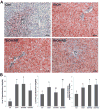Dietary nicotinic acid supplementation ameliorates chronic alcohol-induced fatty liver in rats
- PMID: 24848081
- PMCID: PMC5742865
- DOI: 10.1111/acer.12396
Dietary nicotinic acid supplementation ameliorates chronic alcohol-induced fatty liver in rats
Abstract
Background: Alcohol abuse frequently causes niacin deficiency in association with the development of alcoholic liver disease. The objective of the present study was to determine whether dietary nicotinic acid (NA) deficiency exaggerates and whether dietary NA supplementation alleviates alcohol-induced fatty liver.
Methods: Male Sprague-Dawley rats were pair-fed with 4 isocaloric liquid diets: control, ethanol (EtOH), EtOH with dietary NA deficiency, and EtOH with dietary NA supplementation, respectively, for 8 weeks. The control and EtOH diets contained normal levels of NA (7.5 mg/l). Dietary NA deficiency (0 mg NA/l) was achieved by removing NA from the vitamin mix, while NA was added to the liquid diet at 750 mg/l for dietary NA supplementation.
Results: Chronic EtOH feeding induced significant lipid accumulation in the liver, which was not worsened by dietary NA deficiency, but was ameliorated by dietary NA supplementation. Liver total NAD, NAD(+) , and NADH levels were remarkably higher in the NA supplemented group than the NA deficient or EtOH alone groups. Dietary NA supplementation to EtOH-fed rats increased the protein levels of hepatic cytochrome P450 4A1 (CYP4A1) and acyl-coenzyme A oxidase 1 without affecting their mRNA levels. Interestingly, we found dietary NA supplementation reduced the ubiquitination level of CYP4A1. In addition, hepatic fatty acid synthase expression was reduced, while the serum β-hydroxybutyrate and adiponectin concentrations were significantly elevated by dietary NA supplementation. Moreover, dietary NA supplementation modulated EtOH-perturbed liver and serum metabolite profiles.
Conclusions: These results demonstrate that alcoholic fatty liver was not exaggerated by dietary NA deficiency, but was ameliorated by dietary NA supplementation. Increased hepatic fatty acid oxidation and decreased hepatic de novo lipogenesis contribute to the effects of dietary NA supplementation.
Keywords: Alcoholic Fatty Liver; Lipid Metabolism; Nicotinic Acid.
Copyright © 2014 by the Research Society on Alcoholism.
Figures






Comment in
-
Nicotinic acid supplementation in the context of alcoholic liver injury: friend or foe?Alcohol Clin Exp Res. 2014 Jul;38(7):1829-31. doi: 10.1111/acer.12506. Alcohol Clin Exp Res. 2014. PMID: 25040591
Similar articles
-
Dietary Fisetin Supplementation Protects Against Alcohol-Induced Liver Injury in Mice.Alcohol Clin Exp Res. 2016 Oct;40(10):2076-2084. doi: 10.1111/acer.13172. Epub 2016 Aug 30. Alcohol Clin Exp Res. 2016. PMID: 27575873 Free PMC article.
-
Nicotinic acid supplementation in the context of alcoholic liver injury: friend or foe?Alcohol Clin Exp Res. 2014 Jul;38(7):1829-31. doi: 10.1111/acer.12506. Alcohol Clin Exp Res. 2014. PMID: 25040591
-
Preservation of hepatocyte nuclear factor-4α contributes to the beneficial effect of dietary medium chain triglyceride on alcohol-induced hepatic lipid dyshomeostasis in rats.Alcohol Clin Exp Res. 2013 Apr;37(4):587-98. doi: 10.1111/acer.12013. Epub 2012 Nov 5. Alcohol Clin Exp Res. 2013. PMID: 23126616 Free PMC article.
-
A pilot study on the effect of early provision of dietary docosahexaenoic acid on testis development, functions, and sperm quality in rats exposed to prenatal ethanol.Birth Defects Res. 2020 Jan 1;112(1):93-104. doi: 10.1002/bdr2.1614. Epub 2019 Nov 7. Birth Defects Res. 2020. PMID: 31697449 Review.
-
Dietary serine supplementation: Friend or foe?Curr Opin Pharmacol. 2021 Dec;61:12-20. doi: 10.1016/j.coph.2021.08.011. Epub 2021 Sep 20. Curr Opin Pharmacol. 2021. PMID: 34547701 Review.
Cited by
-
Modulation of Intestinal Barrier and Bacterial Endotoxin Production Contributes to the Beneficial Effect of Nicotinic Acid on Alcohol-Induced Endotoxemia and Hepatic Inflammation in Rats.Biomolecules. 2015 Oct 16;5(4):2643-58. doi: 10.3390/biom5042643. Biomolecules. 2015. PMID: 26501337 Free PMC article.
-
D-glucaro-1,4-lactone alleviates acetaminophen-induced hepatotoxicity in mice via modulating gut microbiota and metabolites associated with Lactobacillus-glutamine and nicotinic acid pathways.Front Pharmacol. 2025 Jul 9;16:1627850. doi: 10.3389/fphar.2025.1627850. eCollection 2025. Front Pharmacol. 2025. PMID: 40703358 Free PMC article.
-
Dietary niacin supplementation improves meat quality, muscle fiber type, and mitochondrial function in heat-stressed Taihe black-bone silky fowls.Front Vet Sci. 2024 Oct 14;11:1491553. doi: 10.3389/fvets.2024.1491553. eCollection 2024. Front Vet Sci. 2024. PMID: 39469586 Free PMC article.
-
Metabolomics Study of Serum from a Chronic Alcohol-Fed Rat Model Following Administration of Defatted Tenebrio molitor Larva Fermentation Extract.Metabolites. 2020 Oct 29;10(11):436. doi: 10.3390/metabo10110436. Metabolites. 2020. PMID: 33138187 Free PMC article.
-
Nicotinamide Adenine Dinucleotide (NAD+) and Enkephalinase Inhibition (IV1114589NAD) Infusions Significantly Attenuate Psychiatric Burden Sequalae in Substance Use Disorder (SUD) in Fifty Cases.Curr Psychiatry Res Rev. 2022 Jul;18(2):125-143. doi: 10.2174/2666082218666220527114427. Epub 2022 Jun 21. Curr Psychiatry Res Rev. 2022. PMID: 36118157 Free PMC article.
References
Publication types
MeSH terms
Substances
Grants and funding
LinkOut - more resources
Full Text Sources
Other Literature Sources
Medical

